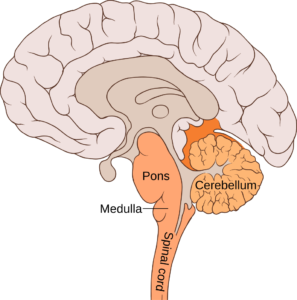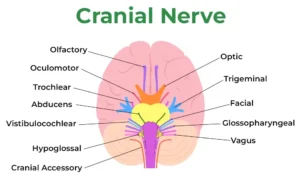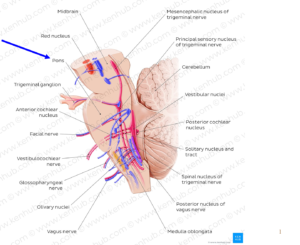Evolution
The pons first evolved as an offshoot of the medullary reticular formation.[10] Since lampreys possess a pons, it has been argued that it must have evolved as a region distinct from the medulla by the time the first agnathans appeared, 525 million years ago.[11]
A number of cranial nerve nuclei are present in the pons:
- mid-pons: the principal sensory nucleus of the trigeminal nerve (V)
- mid-pons: the motor nucleus for the trigeminal nerve (V)
- lower down in the pons: abducens nucleus (VI)
- lower down in the pons: facial nerve nucleus (VII)
- lower down in the pons: vestibulocochlear nuclei (vestibular nuclei and cochlear nuclei) (VIII)
Function
Functions of these four cranial nerves (V-VIII) include regulation of respiration, control of involuntary actions, sensory roles in hearing, equilibrium, and taste, and in facial sensations such as touch and pain, as well as motor roles in eye movement, facial expressions, chewing, swallowing, and the secretion of saliva and tears.[2]
The pons contains nuclei that relay signals from the forebrain to the cerebellum, along with nuclei that deal primarily with sleep, respiration, swallowing, bladder control, hearing, equilibrium, taste, eye movement, facial expressions, facial sensation, and posture.[2]
Within the pons is the pneumotaxic center consisting of the subparabrachial and the medial parabrachial nuclei. This center regulates the change from inhalation to exhalation.[2]
The pons is implicated in sleep paralysis, and may also play a role in generating dreams.[9]
Clinical significance
- Central pontine myelinolysis is a demyelinating disease that causes difficulty with sense of balance, walking, sense of touch, swallowing and speaking. In a clinical setting, it is often associated with transplant or rapid correction of blood sodium. Undiagnosed, it can lead to death or locked-in syndrome.
NB micro bleeding is not discussed above!



